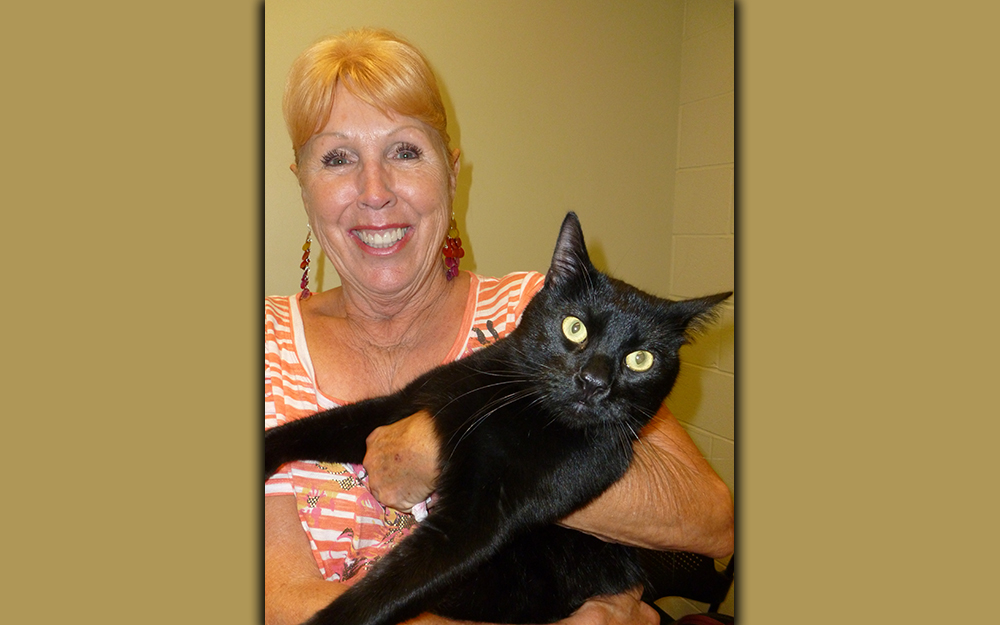
BY JANET McAFEE
Glorious black cats and dogs are waiting for you to adopt them! Their shining ebony coats glisten in the winter sun, and their striking amber gold eyes peer at you longingly. Unfortunately, black animals are shrouded in negative superstitions, and they have a harder time getting adopted than their light colored counterparts. Folks who visit a shelter are more likely to leave with a light colored, multicolored, or animal with interesting markings. There are no scientific studies to confirm why this is true, although theories abound.
In kennels containing multiple animals, those with black fur are harder to see. People often fall in love with animals at first sight, and animals that are easier to see are more likely to get picked up, played with, and adopted. People spot the fluffy white dogs and Siamese looking cats and don’t look further.
It’s almost Halloween, and some rescue groups hesitate to adopt black cats in October, fearing they might end up in the wrong hands. With proper screening and home checks, most animal welfare groups realize we need to find homes throughout the year because there are so many homeless animals.
Black Animals are hard to Photograph – Pet adoptions are often promoted on websites, Facebook, and other social media. Petfinder and Pet Harbor are popular websites featuring photographs and biographies of rescue animals. The best of photographers must make a special effort to light a black cat or dog enough so that its facial characteristics can be seen. Without a clear view of its face and expression, potential adopters have a hard time relating to an animal’s personality.
Black Dogs in Movies – Think about your favorite dogs from movies and television. The lighter colored ones get the leading roles as in Lassie, Old Yeller, and The Shaggy Dog. They are easier to film, and their facial expressions are more obvious to audiences. In the movie Beethoven, a brown and white St. Bernard played the happy family dog, while black colored Doberman Pinschers played the bad dogs who snarled and threatened our hero dog. Just like the villainous cowboys in old movies who wore black hats, black dogs in the media are portrayed as the bad guys.
Black Cat Superstitions – In the past, black cats were associated with witchcraft or evil. Today, they remain the poster pets for Halloween, portrayed as scary creatures that conjure fear and loathing. While everyone knows intellectually black animals have no association with evil, these stereotypes can unconsciously impact our preferences. Because they have no other markings, the eyes of solid black cats can appear ominous.
Efforts to Promote Black Pets – Many rescue organizations feature special adoption events, including reduced adoption fees for black pets. Best Friends Animal Society has a nationwide “Back in Black” month of events during May to encourage adoptions.
Owners of black animals will tell you they are fabulous. Just ask Vicki Arrowood, pictured here with Spanky, adopted from a Riverside county shelter, the Coachella Valley Animal Campus. Vicki states, “Spanky is the most engaging animal, he was all over the glass of his enclosure. When I got him into the visiting area, he was very curious and friendly. He seemed to be saying ‘don’t leave me.'”
You can meet wonderful cats and dogs of every color at the Coachella Valley Animal Campus in Thousand Palms, www.rcdas.com (760) 343-3644. Kittyland in Desert Hot Springs might have your new best feline “furfriend”, www.Kittylandrescue.org, (760) 251-2700.
Contact Loving All Animals at (760) 834-7000 and www.lovingallanimals.org for more information about adopting a rescue animal. They will help you find a new faithful friend, whatever shade that might be!
jmcafee7@verizon.net












































